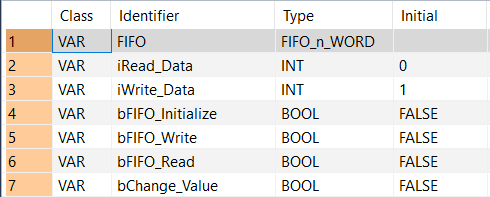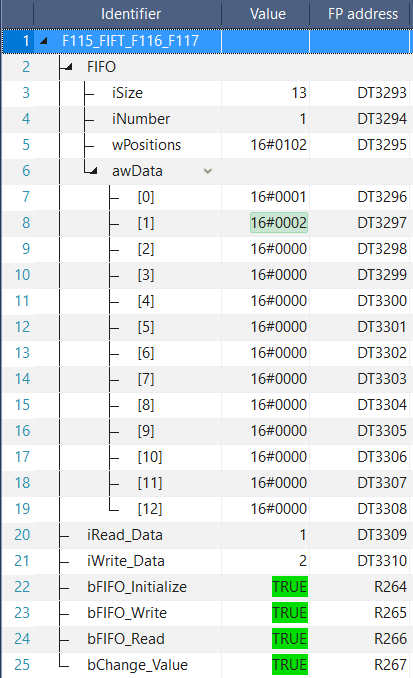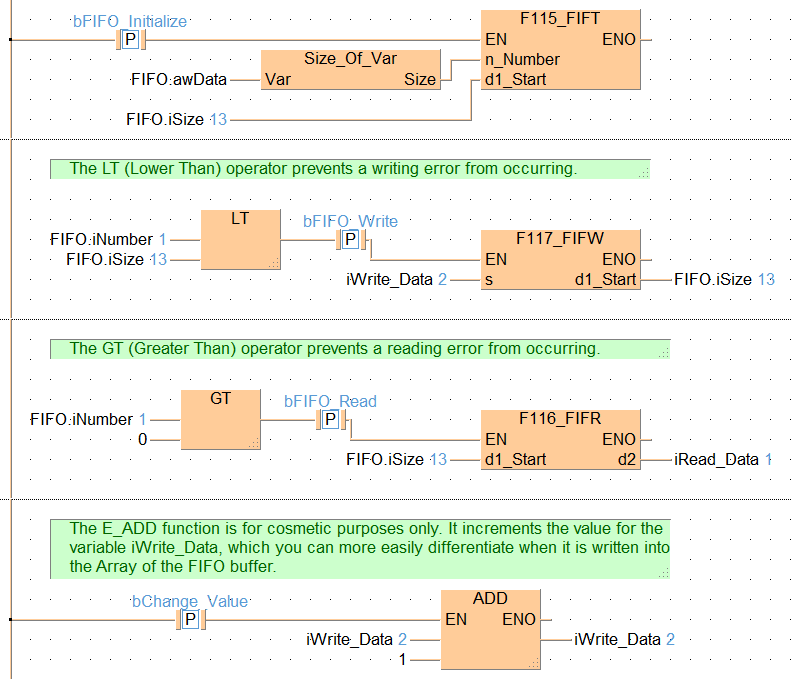


 F117_FIFW
F117_FIFWWrite to FIFO buffer
F/P117 writes the data specified by s into the FIFO buffer specified by d1.

Input
16-bit area or equivalent constant for storing data to write in the FIFO buffer
Output
starting 16-bit area of FIFO buffer
Instead of using this F instruction, we recommend using the corresponding FP7 instruction: FP_FIFO_WRITE, FP_LIFO_WRITE
The specified data is written to the address indicated by the writing pointer when the instruction is executed.

(0), (n-2) and (n-1) are addresses assigned to the data storage area.
n is the value specified by the F115_FIFT instruction.
The writing pointer is stored in the lower eight bits of the third word of the FIFO buffer area, and is indicated by a relative position in the data storage area. The actual address to which data is being written is specified by d1 plus the offset 3 plus the value of the writing pointer (the value of which only the lower byte is a decimal value).
When the writing is executed, 1 is added to the number of stored data items, and the writing pointer is incremented by 1, or reset to zero if the writing pointer pointed to the final element.
The variables s and d1_Start have to be of the same data type.
An error occurs if this is executed when the FIFO buffer is full (the number of stored data items = the size n of the FIFO defined by the FIFT instruction). Writing is inhibited.
If this is executed when the writing pointer is indicating the final address in the FIFO buffer (the "n" value defined by the FIFT instruction), the writing pointer will be set to 0.
if the size (n) of the FIFO specified by d1_Start is n = 0, or when n > 256.
if the number of stored data items of the FIFO = 0.
if the number of stored data items of the FIFO > FIFO size (n).
if the final address of the FIFO based on the FIFO size (n) exceeds the area.
if the FIFO writing pointer > FIFO size (n).
if the FIFO writing pointer is 256 (16#100) or higher after the data has been written.
if the size (n) of the FIFO specified by d1_Start is n = 0, or when n > 256.
if the number of stored data items of the FIFO = 0.
if the number of stored data items of the FIFO > FIFO size (n).
if the final address of the FIFO based on the FIFO size (n) exceeds the area.
if the FIFO writing pointer > FIFO size (n).
if the FIFO writing pointer is 256 (16#100) or higher after the data has been written.


All input and output variables used for programming this function have been declared in the POU header. The same POU header is used for all programming languages.

VAR
FIFO: FIFO_n_WORD;
iRead_Data: INT:=0;
iWrite_Data: INT:=1;
bFIFO_Initialize: BOOL:=FALSE;
bFIFO_Write: BOOL:=FALSE;
bFIFO_Read: BOOL:=FALSE;
bChange_Value: BOOL:=FALSE;
END_VARThe example below illustrates the status of the buffer after bFIFO_Write has been enabled twice and bFIFO_Read once. When bFIFO_Write was activated the first time, the value 1 was written into FIFO.awData[0]. When bFIFO_Read was enabled, iRead_Data then read this value. When bFIFO_Write was enabled the second time, the writing pointer was incremented by one and the value 2 written into FIFO.awData[1]. see Entry Data Monitor 1



BODY
WORKSPACE
NETWORK_LIST_TYPE := NWTYPELD ;
END_WORKSPACE
NET_WORK
NETWORK_TYPE := NWTYPELD ;
NETWORK_LABEL := ;
NETWORK_TITLE := ;
NETWORK_HEIGHT := 7 ;
NETWORK_BODY
B(B_CONTACT,,bFIFO_Initialize,6,1,8,3,R);
B(B_F,F115_FIFT,,24,0,33,5,,?DEN?Dn?Dd1?AENO);
B(B_VARIN,,FIFO.awData,11,3,13,5,);
B(B_F,Size_Of_Var,,13,2,23,5,,?D@'Var'?CSize);
B(B_VARIN,,FIFO.iSize,11,5,13,7,);
L(1,0,1,7);
L(1,2,6,2);
L(8,2,24,2);
L(23,3,24,3);
L(23,3,23,4);
L(24,4,24,6);
L(13,6,24,6);
END_NETWORK_BODY
END_NET_WORK
NET_WORK
NETWORK_TYPE := NWTYPELD ;
NETWORK_LABEL := ;
NETWORK_TITLE := ;
NETWORK_HEIGHT := 9 ;
NETWORK_BODY
B(B_COMMENT,,The LT (Lower Than) operator prevents a writing error from occurring.,3,1,33,2,);
B(B_VARIN,,FIFO.iNumber,8,4,10,6,);
B(B_F,@LT-2,,10,3,15,7,,?D?D?C);
B(B_CONTACT,,bFIFO_Write,17,4,19,6,R);
B(B_VARIN,,FIFO.iSize,8,5,10,7,);
B(B_F,F117_FIFW,,24,4,33,8,,?DEN?D@'s'?AENO?Cd1);
B(B_VARIN,,iWrite_Data,22,6,24,8,);
B(B_VAROUT,,FIFO.iSize,33,6,35,8,);
L(1,0,1,9);
L(15,5,17,5);
L(19,5,19,6);
L(19,6,24,6);
END_NETWORK_BODY
END_NET_WORK
NET_WORK
NETWORK_TYPE := NWTYPELD ;
NETWORK_LABEL := ;
NETWORK_TITLE := ;
NETWORK_HEIGHT := 9 ;
NETWORK_BODY
B(B_COMMENT,,The GT (Greater Than) operator prevents a reading error from occurring.,3,1,34,2,);
B(B_VARIN,,FIFO.iNumber,7,4,9,6,);
B(B_F,@GT-2,,9,3,14,7,,?D?D?C);
B(B_CONTACT,,bFIFO_Read,16,4,18,6,R);
B(B_VARIN,,0,7,5,9,7,);
B(B_F,F116_FIFR,,24,4,33,8,,?DEN?Dd1?AENO?Cd2);
B(B_VARIN,,FIFO.iSize,22,6,24,8,);
B(B_VAROUT,,iRead_Data,33,6,35,8,);
L(1,0,1,9);
L(14,5,16,5);
L(18,5,18,6);
L(18,6,24,6);
END_NETWORK_BODY
END_NET_WORK
NET_WORK
NETWORK_TYPE := NWTYPELD ;
NETWORK_LABEL := ;
NETWORK_TITLE := ;
NETWORK_HEIGHT := 9 ;
NETWORK_BODY
B(B_COMMENT,,The E_ADD function is for cosmetic purposes only. It increments the value for the variable iWrite_Data~ which you can more easily differentiate when it is written into the Array of the FIFO buffer.,3,1,34,4,);
B(B_CONTACT,,bChange_Value,9,5,11,7,R);
B(B_F,E_ADD-2,,22,4,28,9,,?DEN?Da_NumN?Da_NumN?AENO?C);
B(B_VARIN,,iWrite_Data,20,6,22,8,);
B(B_VAROUT,,iWrite_Data,28,6,30,8,);
B(B_VARIN,,1,20,7,22,9,);
L(1,0,1,9);
L(1,6,9,6);
L(11,6,22,6);
END_NETWORK_BODY
END_NET_WORK
END_BODY
IF DF(bFIFO_Initialize) THEN
(* Create the FIFO buffer *)
F115_FIFT(n_Number := Size_Of_Var(FIFO.awData), d1_Start := FIFO.iSize);
REPEAT
(* Initialize FIFO buffer with values *)
iWrite_Data:=iWrite_Data+1;
F117_FIFW(s := iWrite_Data, d1_Start => FIFO.iSize);
UNTIL(FIFO.iNumber>=FIFO.iSize)
END_REPEAT;
END_IF;
IF DF( bFIFO_Write) THEN
(* Write value of Write_Data to FIFO buffer *)
(* at leading edge of FIFO_Write *)
F117_FIFW(s := iWrite_Data, d1_Start => FIFO.iSize);
END_IF;
IF DF(bFIFO_Read) THEN
(* Read value from FIFO buffer *)
(* at leading edge of FIFO_Read *)
F116_FIFR(d1_Start := FIFO.iSize, d2 => iRead_Data);
END_IF;